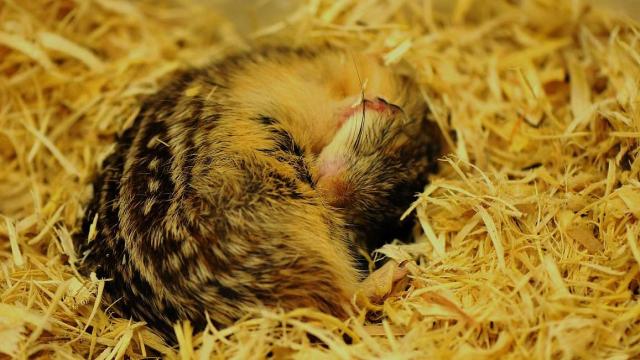Squirrels and other hibernating animals have an almost magical ability to withstand frigid temperatures. New research has uncovered the biological factors involved in keeping cellular structures intact during hibernation — a finding that could eventually be used to preserve human organs prior to transplantation.
A hibernating 13-lined ground squirrel.Photo: NIH
There’s no question that according to the US Department of Health and Human Services.
Around 35 per cent of all US deaths could be prevented or delayed by organ transplantation, but while 95 per cent of Americans support organ donation, only 40 per cent are registered donors. And then there’s the timing aspect; the availability of organs doesn’t always coincide with a patient in need. Hence the need for viable organ preservation methods.
One possible solution, as proposed in a Cell paper published this week, involves leveraging the power of hibernation. Or more specifically, leveraging the biological processes that make hibernation possible. The new research, conducted by scientists at the National Eye Institute, a part of the National Institutes of Health, reveals the remarkable cellular mechanisms that enable ground squirrels to survive exposure to frigid conditions as they wait out the winter months.
Their promising experiments suggest that similar processes could be applied to human tissue, allowing for the long-term preservation of organs.
Researcher Wei Li, a senior investigator in the NEI Retinal Neurophysiology Section, and his colleague Jingxing Ou, studied cells of the common 13-lined ground squirrel (Ictidomys tridecemlineatus). This North American rodent features 13 alternating brown and white lines that extend along the length of its body (hence its name), but more importantly, it’s a hibernating mammal.
As the new research shows, the cells of these animals contain microtubule cytoskeletons — small tubes that form strong structural networks within cells while also allowing for the transportation of organelles and molecular compounds required for cellular health and survival.
For the study, the researchers compared the cells of non-hibernating animals, such as humans and rats, with cells from the 13-lined ground squirrel as they searched for the factors responsible for the animals’ different responses to cold. At temperatures nearing the freezing point, the microtubule cytoskeletons in the squirrel’s brain cells remained intact, but the cold caused those same structures to collapse in the neural cells of humans and rats, resulting in cellular death.

Top: Normal cells from a mouse kidney prior to cooling show the microtubule structure is intact. Middle: After 24 hours at 4 degrees C and rewarming, the microtubule structure has disappeared. Top: The microtubule structure in the cells pretreated with the drug combination before cooling and rewarming closely resemble that of normal cells. Image: NIH
To figure out what’s going on at the biological level, Li and Ou created an in vitro version of the process they dubbed “hibernation in a dish.” By reprogramming the cells of newborn ground squirrels into stem cells, the researchers were able to retain the cold-adaptive characteristics of the cells; and because stem cells can be turned into basically any other kind of cell, the researchers were able to study how various squirrel cells were able to adapt to the cold.
In lab experiments, the researchers compared differences in the genetic expression of stem-cell derived neural cells in both squirrels and humans. When it got cold, human brain cells over-produced a reactive oxygen compound (ROS) that resulted in major problems, including the oxidation of proteins along the microtubules that caused the structure to fail.
In squirrels, however, ROS levels stayed low, and the microtubules remained intact. At the same time, exposure to cold also impaired the ability of neurons to dispose of toxic oxidised proteins, called proteases, which destroyed nearby microtubules.
The researchers then sought to determine if it was possible to suppress these debilitating process in non-hibernating cells. To that end, they treated a variety of human, mouse, and rat cells with a drug that reduces the production of ROS and a drug that inhibits protease activity. After exposing these treated cells to 4°C temperatures for 24 hours, the researchers watched as the microtubule structures were preserved in both human stem cell-derived neurons and non-neural tissue.
The microtubes in the cells of mice kidneys, for example, demonstrated strong integrity after cooling and warming. The method was also applied to the retinas of rats, preserving both structure and functionality of the organ.
More work still needs to be done, such as testing the method on non-stem cell derived cells, but it’s a promising start. The technique could be used to cool and preserve organs prior to transplantation, and to also allow for surgically induced hypothermia for patients with traumatic brain injuries.
“By understanding the biology of cold adaptation in hibernation, we may be able to improve and broaden the applications of induced hypothermia in the future, and perhaps prolong the viability of organs prior to transplantation,” said Li in a statement.
“Kidneys, for example, are typically stored for no more than 30 hours. After that, the tissue starts to deteriorate, impairing the organ’s ability to function properly after its been rewarmed and [restored]. Heart, lungs and livers have an even shorter shelf life.”
It may be years until we see this technology applied in a clinical setting, so until then, be sure to fill out your organ donor card.
[Cell]
